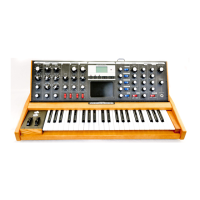23
When the resonant peaks of the lowpass filters pass through the overtones of the
sound being filtered, those overtones are reinforced. This gives the filter a nice
character that sounds vocal, quacky, or zappy, depending on how it’s used. When
the resonance is turned up past 8, the filters begin to self-oscillate at the cutoff
frequency, producing a sine wave tone. The Keyboard Control Amount control sets
how much the filters’ cutoff frequencies track the keyboard note that is played. As
you play higher on the keyboard, the cutoff frequency goes higher, too.
The Voyager features two filter modes: Dual Lowpass and Highpass/Lowpass
DUAL LOWPASS MODE:
The Voyager’s dual Lowpass filter mode features two lowpass filters which are routed
to the left or right audio output. The Cutoff knob controls the frequency cutoffs of
both filters. The filters can be set to the same cutoff frequency, or different cutoff
frequencies with the Spacing control (figure 20). When the two filters are set at
different cutoff frequencies and routed to two different speakers, what you hear is a
fantastically swirly and vocal sound – halfway between a phaser and a lowpass
filter.

